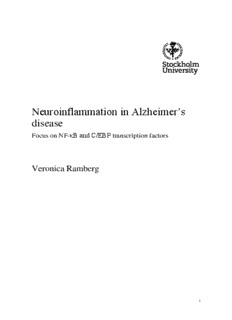
Neuroinflammation in Alzheimer‟s disease - DiVA PDF
Preview Neuroinflammation in Alzheimer‟s disease - DiVA
Neuroinflammation in Alzheimer‟s disease Focus on NF-κB and C/EBP transcription factors Veronica Ramberg i Cover photo: James Lauritz, Getty Images ©Veronica Ramberg, Stockholm 2011 ISBN 978-91-7447-356-8 Printed in Sweden by Universitetsservice US-AB, Stockholm 2011 Distributor: Department of Neurochemistry, Stockholm University ii Till Carl, Victor och Erik iii iv List of publications This thesis is based on the following publications, referred to in the text by their corresponding Roman numerals: I Fisher L., Samuelsson M., Jiang Y., Ramberg V., Figueroa R., Hallberg E., Langel Ü., Iverfeldt K. “Targeting cytokine expression in rat primary glial cells by cellular delivery of an NF-κB decoy.” Journal of Molecular Neuroscience, 31:209-219 (2007) II Samuelsson M., Ramberg V., Iverfeldt K. “Alzheimer Aβ peptides block the activation of C/EBPβ and C/EBPδ in glial cells.” Biochemical and Biophysical Research Communica- tions, 370:619-622 (2008) III Ramberg V., Tracy L., Samuelsson M., Nilsson L.N.G., Iverfeldt K. “The CCAAT/enhancer binding protein (C/EBP) δ is differently regulated by fibrillar and oligomeric forms of the Alzheimer amyloid-β peptide.” Journal of Neuroinflammation, 8:34 (2011) IV Figueroa R.*, Ramberg V.*, Gatsinzi T., Samuelsson M., Zhang M., Iverfeldt K., Hallberg E. “Anchored FRET sensors detect local caspase activation prior to neuronal degeneration.” Molecular Neurodegeneration, 6:35 (2011) *The first two authors made equal contributions. v vi Abstract Alzheimer‟s disease (AD) is the most common form of dementia among elderly. The disease is characterized by amyloid-β (Aβ) plaques, neurofibrillary tangles, loss of synapses and neurons and chronic neuroinflammation. The significance of neuroinflammatory processes in disease on-set and progression has been debated since activated microglia and reactive astrocytes have been attributed both protective and damaging properties. However, patients systematically treated with anti-inflammatory drugs have been shown to develop AD to a lesser extent than average. This indicates an important role of neuroinflammation in AD. This thesis focuses on two inflammatory related transcription fac- tors, nuclear factor κB (NF-κB) and CCAAT/enhancer binding protein (C/EBP). Both NF-κB and C/EBP are known regulators of many pro- inflammatory genes and may during certain circumstances dimerize with each other. In paper I we use a new strategy to inhibit NF-κB DNA binding ac- tivity in primary astro-microglial cell cultures treated with Aβ and IL- 1β. By coupling the NF-κB decoy to a transport peptide both concen- tration and incubation time can be shortened in comparison to previ- ous studies. Moreover, using the same in vitro model in paper II and III, we show members of the C/EBP family to be dysregulated during AD mimicking conditions. Additional focus was directed towards C/EBPδ, which was shown to respond differently to oligomeric and fibrillar forms of Aβ. Results were also confirmed in vivo using an AD mouse model characterized by high levels of fibrillar Aβ deposits. Finally, in order to get further insight in neurodegenerative processes, induced by Aβ or microglial activation, we present in paper IV a new set of anchored sensors for detection of locally activated caspases in neuronal cells. By anchoring the sensors to tau they become less dy- namic and caspase activation can be detected early on in the apoptotic process, in a spatio-temporal and reproducible manner. vii viii Contents Abbreviations xi Introduction 1 Alzheimer’s disease 1 Pathological hallmarks 2 Neuroinflammation in AD 3 The immune system of the brain 4 Microglia 4 Astrocytes 8 Microglia-astrocyte cross talk 10 Inflammaging 11 Transcription factors involved in the inflammatory response 12 Transcription and the role of transcription factors 13 Nuclear factor-B 14 CCAAT/enhancer binding protein 15 Cytokines - effector molecules in AD 19 Interleukin-1 19 Interleukin-6 20 Non-steroidal anti-inflammatory drugs and AD 21 Neurodegeneration in AD 22 Roles of caspases in apoptotic cell death 22 The involvement of caspases in AD 23 Methods to determine caspase activation and cell death 24 Aims of the thesis 26 Methodological considerations 27 In vitro and in vivo model systems 27 Primary astro-microglial cultures (paper I-III) 27 Arc-Swe transgenic mice (paper III) 27 Cell lines (paper IV) 28 Cell treatments 28 IL-1β and LPS (paper I-III) 28 Amyloid-β (paper I-IV) 29 Cell penetrating peptides (CPP) (paper I) 30 KillerRed (paper IV) 30 ix Staurosporine (paper IV) 30 Studies of protein-DNA interactions 31 Electrophoretic mobility shift assay (paper I-III) 31 Streptavidin-agarose pull-down (paper III) 31 Reverse transcriptase-polymerase chain reaction (paper I) 32 Western blot (paper II-IV) 33 Laser scanning confocal microscopy (paper I and IV) 33 Results and discussion 35 Paper I: Targeting cytokine expression in rat primary glial cells by cellular delivery of an NF-κB decoy. 35 Paper II: Alzheimer Aβ peptides block the activation of C/EBPβ and C/EBPδ in glial cells. 37 Paper III: The CCAAT/enhancer binding protein (C/EBP) δ is differently regulated by fibrillar and oligomeric forms of the Alzheimer amyloid-β peptide. 38 Paper IV: Anchored FRET sensors detect local caspase activation prior to neuronal degeneration. 41 Concluding remarks 45 Populärvetenskaplig sammanfattning på svenska 46 Acknowledgements 48 Referenes 50 x
Description: